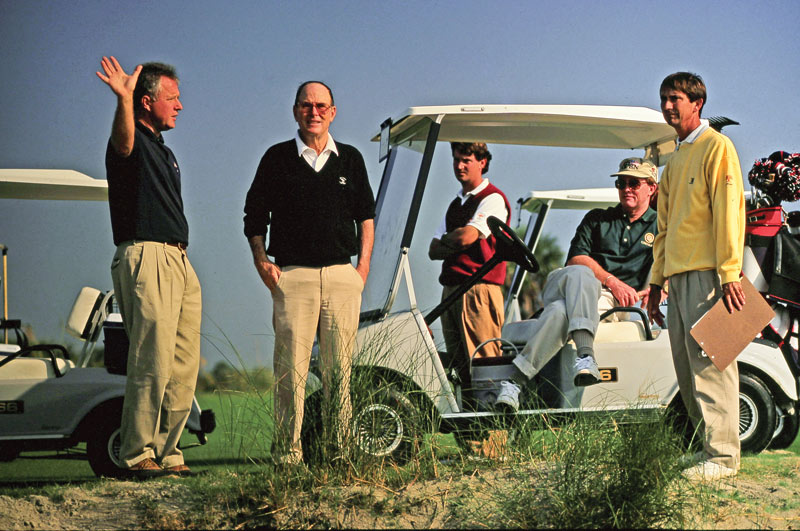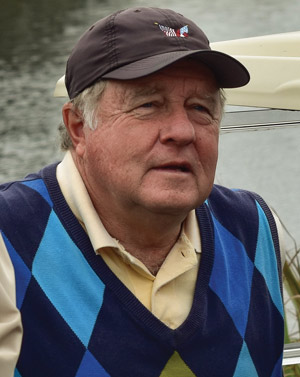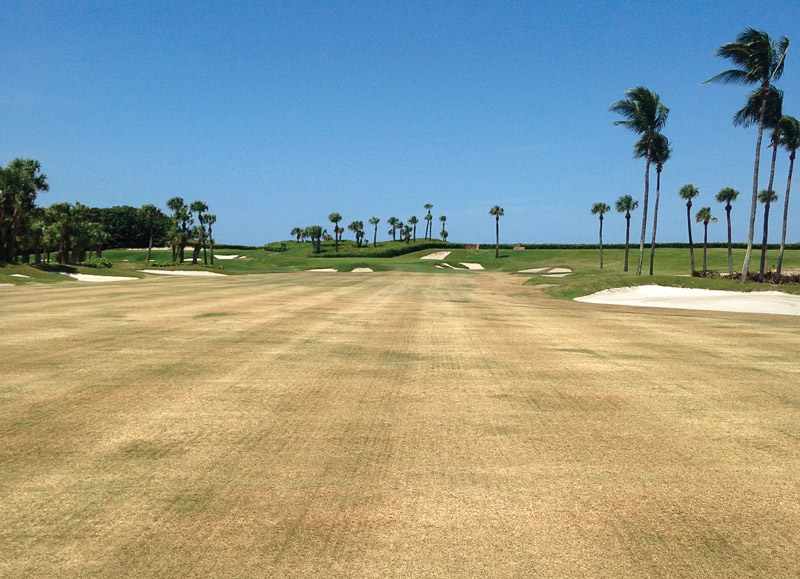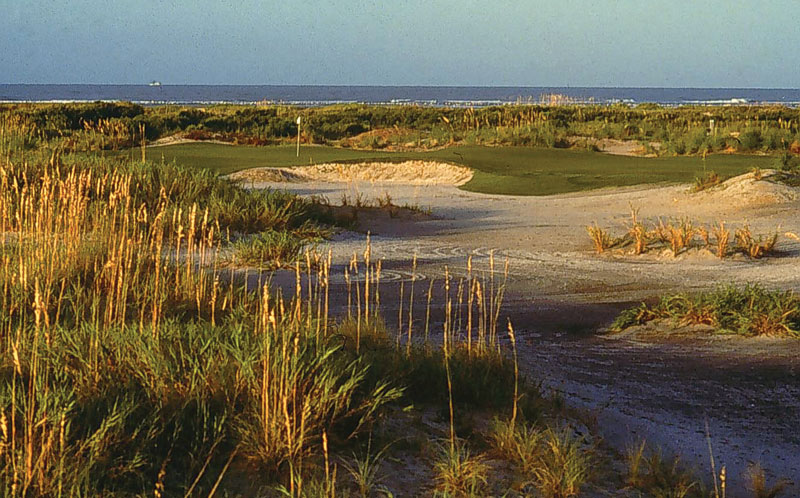
Author George Frye (second from left) consults with late legendary designer Pete Dye at the Ocean Course at Kiawah Island (S.C.) Golf Resort. Photo courtesy of George Frye
Editor’s note: A version of this article appeared in the January/February 2022 issues of Carolinas Green, the publication of the Carolinas GCSA.
The following “12 pillars” are the foundation for helping someone become the best golf superintendent they can be. The order may vary based on opinion, type of course (public, private, resort or semi-private), or any number of other factors. But based on what I’ve learned in my 40 years in the industry, and in the minds of the half dozen or so current top-of-the-line superintendents I shared this with, these are the categories that matter the most.
The other thing we all agree on is that No. 1 on this list — “Know what ‘good’ is” — should always be No. 1. This pillar serves as a building block for all the others. If someone doesn’t know what “good” is, then all the other pillars become somewhat irrelevant. You have to know what good is to know where to go from there.
So, here are the 12 pillars that underpin the career of a good golf course superintendent:
1. Know what “good” is
“Good” in golf course maintenance is a relative term that reflects the value of how something should be based on opinion, experience and background. It is a standard of excellence. This standard of excellence is expressed by what we strive for in terms of quality. As we strive for this quality factor, we usually compare it with something that we can relate to. To understand what good is, you have to be around it.
If you are a golfer, and you only play your course, your concept of “good” might be limited to the environment you are used to. If you truly want to understand the term, you need to explore the best constantly and see why the best is regarded as such.
Then relate it to your circumstances and situation — i.e., budget, conditioning, design, expectation, etc. If our perception of “good” is restricted by limiting the environments that we expose ourselves to, then we are also limiting ourselves to what we can accomplish and produce.
The best recommendation to anyone starting in this business is to expose yourself to the best. This will give you wisdom, knowledge and expertise. As a result, you will develop a benchmark for success and a standard that will stay with you forever — no matter what course you maintain.
2. Understand playability
Playability is a measure of how course conditioning helps or hinders the golf course’s capacity to deliver on the goals of the golfer and the golf course architect. It represents what the game is all about. Understanding playability starts with understanding golfer expectations. This is done by maintaining the course in such a way that the design and playability complement each other. In simple terms, see your golf course through the eyes of a golfer and how the architect intended for the golf course to play.
If you don’t play golf, ask the golfers what they think. They will tell you. Golfers typically don’t care about aesthetics, but they appreciate aesthetics. One thing is for sure: They do scrutinize playability. Playability represents what the game of golf is all about. So, gain a perspective of how the golf course should play relative to its design. This is the key to success and golfer happiness.
3. Communication
Successful communication can be a superintendent’s most valuable tool. It can set the tone for everything he or she does. Good communication builds trust and respect from the top down and the bottom up as it relates to goals, knowledge and challenges. The best way to build professionalism and awareness by the superintendent is keeping golfers, members, owners and staff informed.
One cannot operate efficiently and successfully by keeping everyone in the dark. This leads to gossip and speculation as to what is going on. Inevitably, this will hurt your credibility and how much confidence people have in you.

Right: Author George Frye.
There are so many ways to communicate in this day and age — emails, newsletters, social media, the spoken word (whether in-person or over the phone). Plan to communicate something about your course every week. This is the best way to let everyone know who you are and why you are such an important asset to your operation. Then, nothing will be left open for interpretation.
Because the superintendent is not constantly in the public eye, communication can be the best public relations tool you can employ. Think of yourself as the ultimate seller of your product, your idea, or method you are advocating.
Being a good salesperson is an educational process. If you do this, everyone involved will come to appreciate all the effort and work that goes into making the golf course the best it can be.
4. Focus on greens
Greens are the most important part of a course. This is the reason golfers often refer to superintendents, mistakenly, as greenskeepers. Originally, the entire playing area of a golf course was referred to as the green, and the superintendent was the green keeper. But as time has gone by and the game and its consumers have changed, the putting greens have become all-important.
Without good greens, nothing else really matters. Good greens require a lot of art and science to maintain.
The art of maintaining good greens is to see what you are looking at based on what you are doing to them. The science of good greens is soil testing, fertilization, soil amendments, etc. The idea is to balance the art and the science to achieve the best putting surface possible. TV commentators mostly talk about greens. This should tell you why greens should be your No. 1 priority. Good greens are your ticket to salvation.
5. Problem-solving
There is an old U.S. Marine Corps saying that applies to the golf course maintenance profession: Improvise, adapt and overcome. Rarely does a day go by that a superintendent need not adjust to unforeseen events. Maintenance is not just about course beautification and playability; it is also about dealing with problems.
If you cannot deal with problems, this business may not be for you, because maintenance is dealing with problems. You must be a proficient problem-solver to be a successful superintendent.
This means having the ability to constantly rebalance, reprioritize and rethink everything you do based on changing conditions and circumstances — staff no-shows, storms, equipment breakdowns, tournaments, construction, disease, etc. You must be flexible in this business. The best plan in the world is subject to change in golf course maintenance, and you must be able to adapt and change with it.
6. The agronomics
Generally, this would seem rather straightforward: Apply good agronomic practices, and the grass will look beautiful. If only it were that simple.
But golf courses are incredibly complex playing surfaces that need to look and play good based on their design. This requires constantly adjusting your agronomics in relation to prevailing conditions — for example, weather — and demands — like tournament time. It can also mean putting the grass under stress to achieve a high level of playability.

Brown is bad, right? Not necessarily. It might not be as pleasing aesthetically as a uniform green sward, but this surface plays firm and fast. Photo by Hal Hicks
Balancing agronomics and playability can be a challenge. It means walking a tightrope between what is fundamentally good for the grass and what is fundamentally good for the playability of the course. Being a critical thinker is a necessary trait. If you are stuck on keeping grass healthy at the expense of playability, then golf course maintenance might not be for you.
This business is not just about growing healthy grass. It is also about maintaining grass for playability in relation to design. However, it should be a foregone conclusion that the more resources a golf course has, the better the golf course conditioning should be.
7. Budget management
Your budget is your road map for the future. It requires thought, organization and insight into what your course needs. Without a budget, you have no road map. And without a road map, you have no path to get where you want to be. Basically, a budget makes you become a good manager because it sets guidelines, goals and a direction for your course.
Building a budget for your course is your foundation for maintaining it. Once your budget is in place, it sets an expectation. How well you manage your budget determines to a high degree the condition of your course. If you are a good budget manager, most likely it will show up in the condition of your course. This requires discipline, control and ingenuity.
8. People skills
One key to success in this business is being able to work with different people on different levels. This makes you a good manager. You must be able to successfully interact with different personalities. As a superintendent and manager, this is a prerequisite to success.
Your staff and professional associates will require one approach. Sales associates, contractors, golfers, company executives and others may require another approach.
Regardless of the people you are working with, you must demonstrate leadership, confidence and understanding, so everyone will want to buy into your ideas, goals and accomplishments. This is the trait of someone with good people skills.
9. Presentation
Presentation is the culmination and combination of everything that complements and enhances the design of the course. It is an overall feeling of consistency, uniformity and attention to detail that brings out the character of a course.

The fifth hole in the early days of the Ocean Course at Kiawah Island is a prime example of presentation that is pleasing to the golfer’s eye. Photo courtesy of George Frye
While the architect is the designer of the course, the superintendent is the finisher, or the paint brush of the course. The superintendent gives the course character and personality through mowing patterns, bunker maintenance, contours, mowing heights, detail, etc. Each of these practices accentuates the features that are built into the course infrastructure. Presentation is creating curb appeal.
A good superintendent creates a product that is pleasing to the golfer’s eye. As the golfer stands on the tee, there is a feeling of awe. Good presentation leaves an impression of quality that is unforgettable.
10. Passion
There are few jobs that require as much passion as being a golf course superintendent. The job never leaves you, even when you are gone from it. This business requires dedication and commitment.
It is not a 9-to-5 job. The golf course becomes part of your life, and you become part of its life. Think of it as a lifestyle, not a career.
Your golf course is there for you seven days a week. If you cannot accept this, the golf maintenance business may not be for you.
Don’t get in this business because you want to play a lot of golf. Get into this business because you have a passion for golf.
11. Pride
The best way to be successful in this business is to ask questions. If you are afraid to ask questions or feel you have all the answers, you are going to fail. There is a saying in the turfgrass business: Pride kills more grass than anything in the world. Ask questions!
This can lead to healthy grass, a healthy course and a healthy outcome. No one knows everything. The best way to learn what you don’t know is to ask. This will help you and your grass.
12. Social skills
Of all the pillars, social skills are the most overlooked. Don’t be a “Caddyshack” superintendent. Make yourself visible. Attend every function you can. Dress and act to fit the occasion. When there is a tournament, make yourself seen. Introduce yourself to everyone. Be a professional at what you do. If you act like a professional, you will be treated as a professional. This will help advance your career.
George Frye, director of golf maintenance at Kiawah Island (S.C.) Golf Resort from 1985-2001, has more than 40 years of experience in golf course maintenance and has worked with the likes of Pete Dye, Robert Trent Jones and Tom Fazio. A 38-year member of GCSAA, he still consults on behalf of his company, TransGolf Inc.